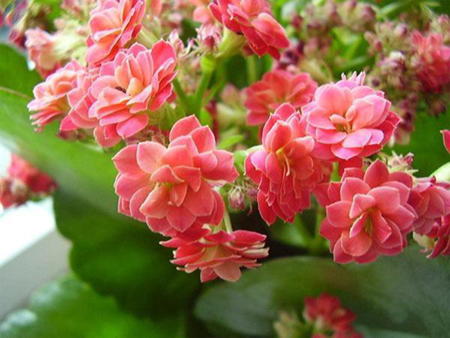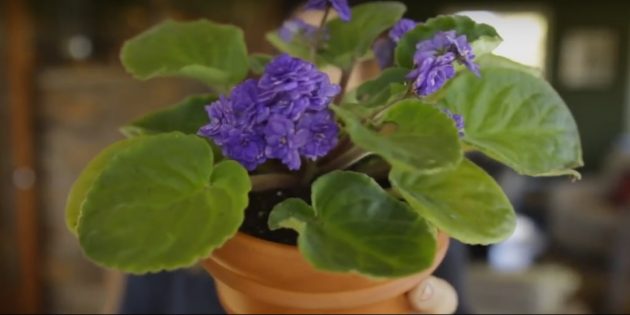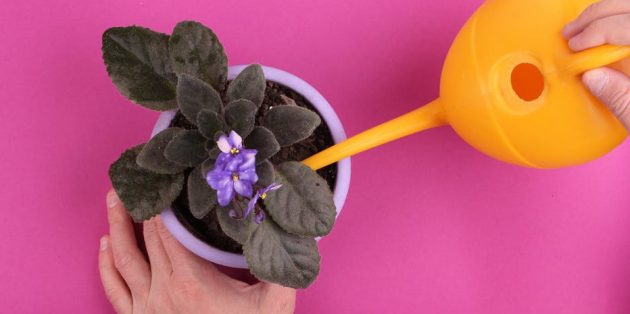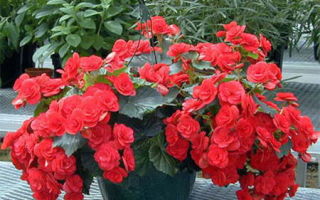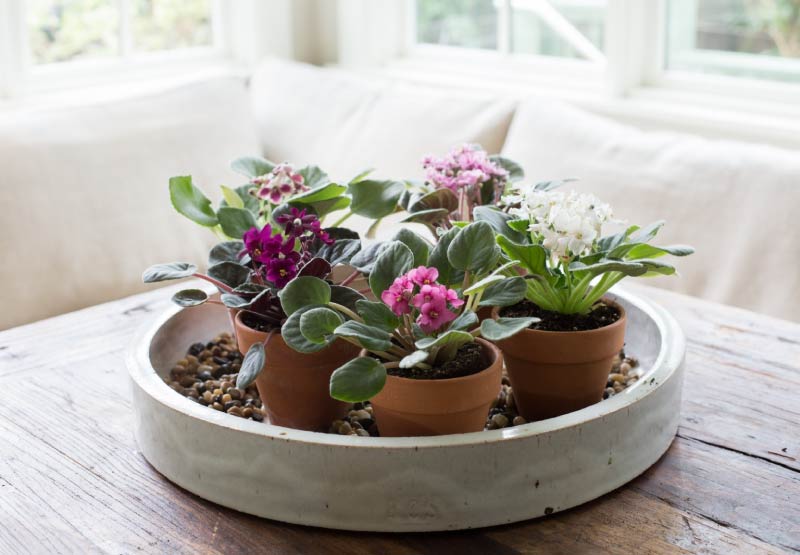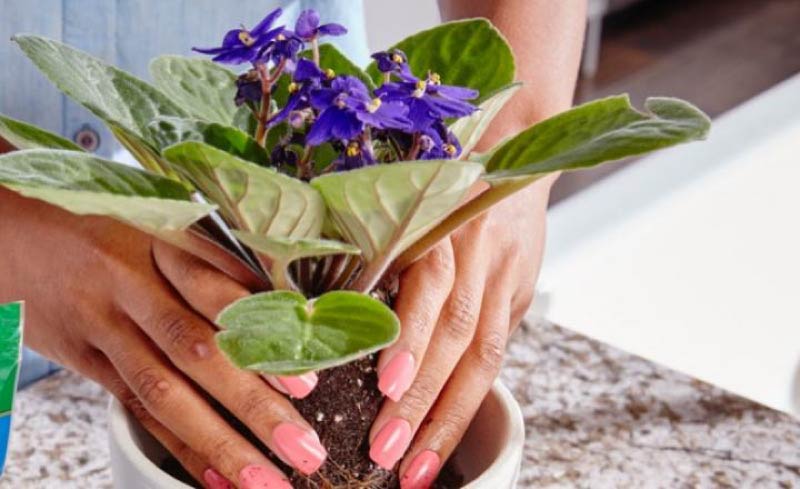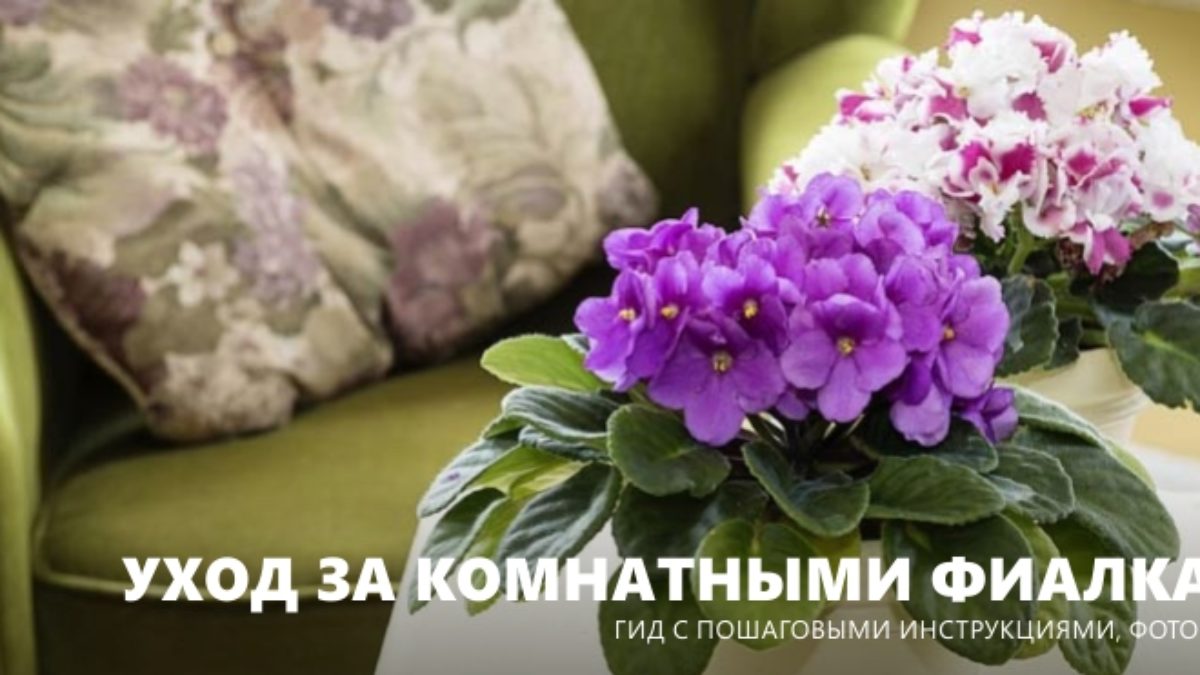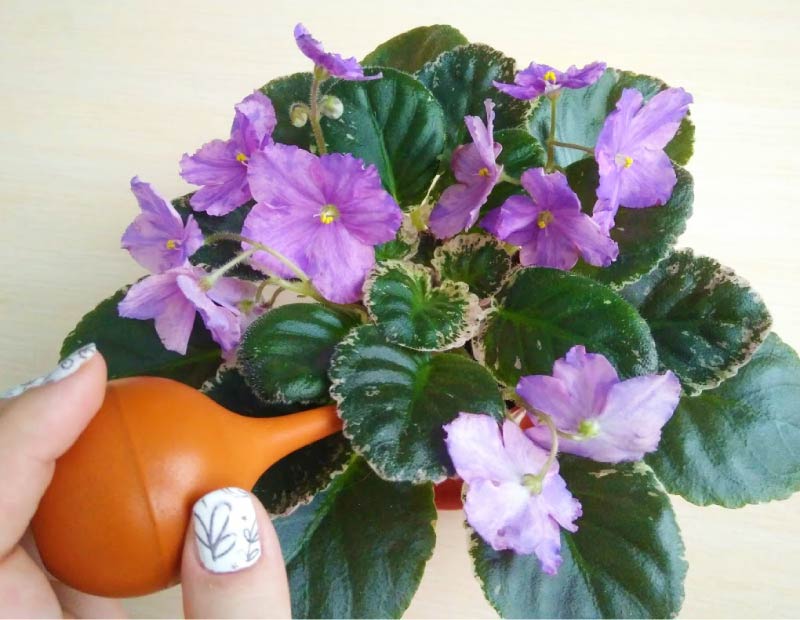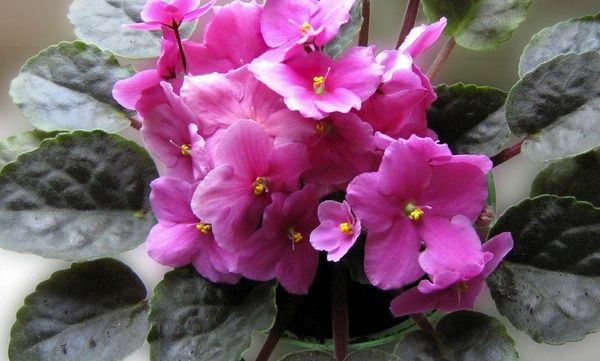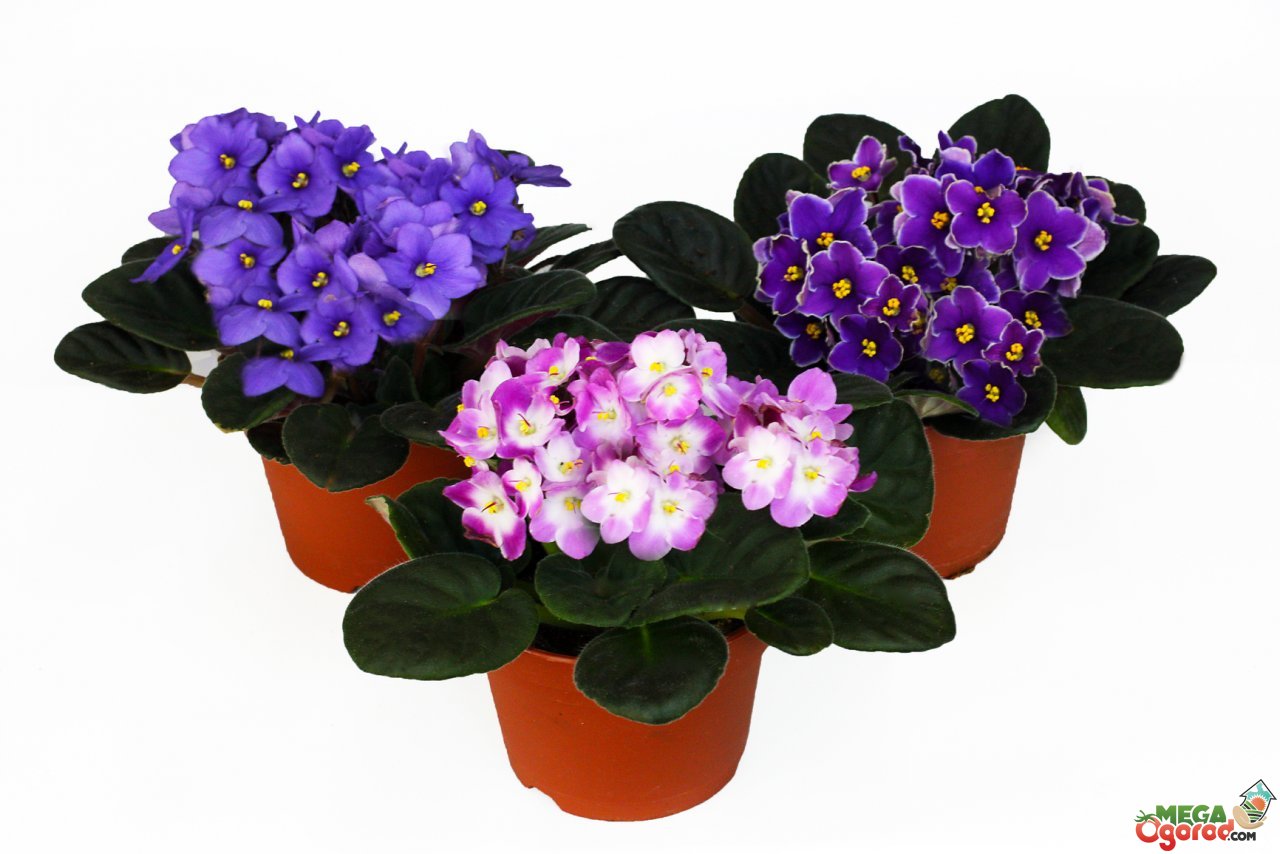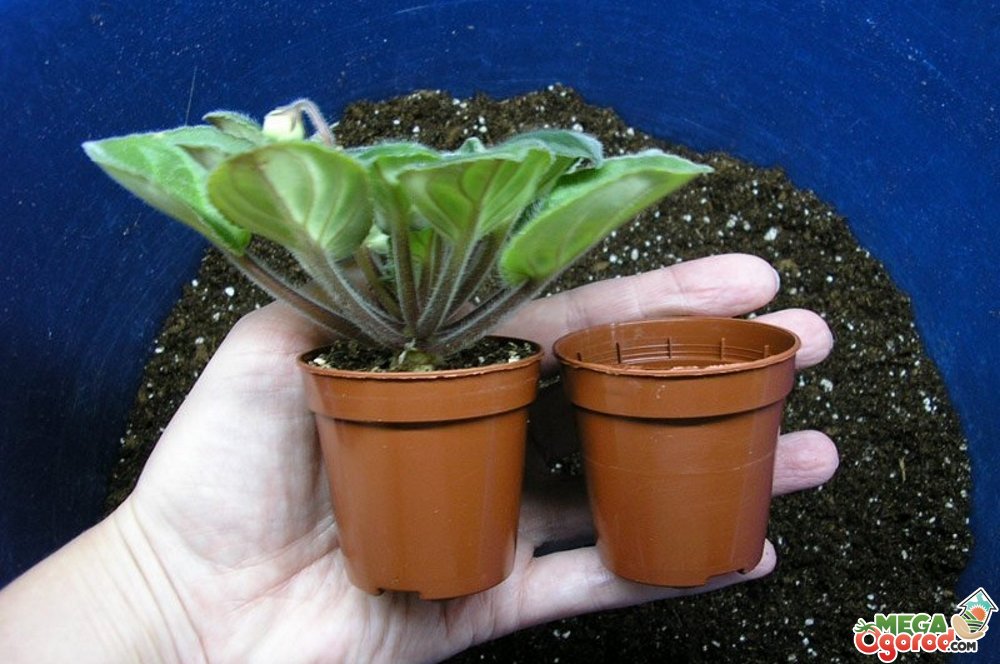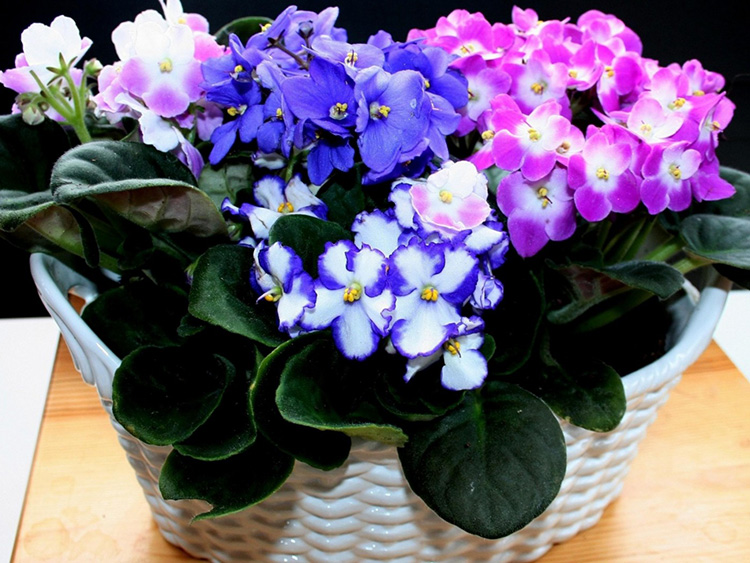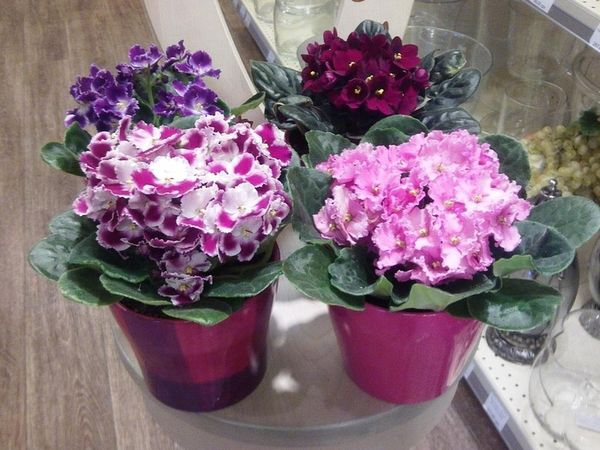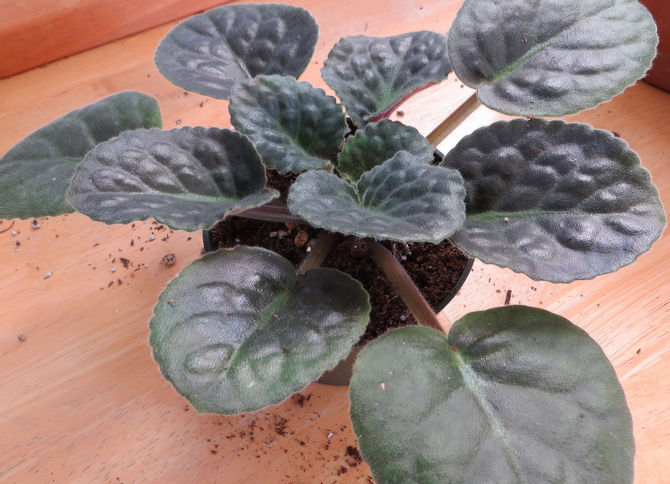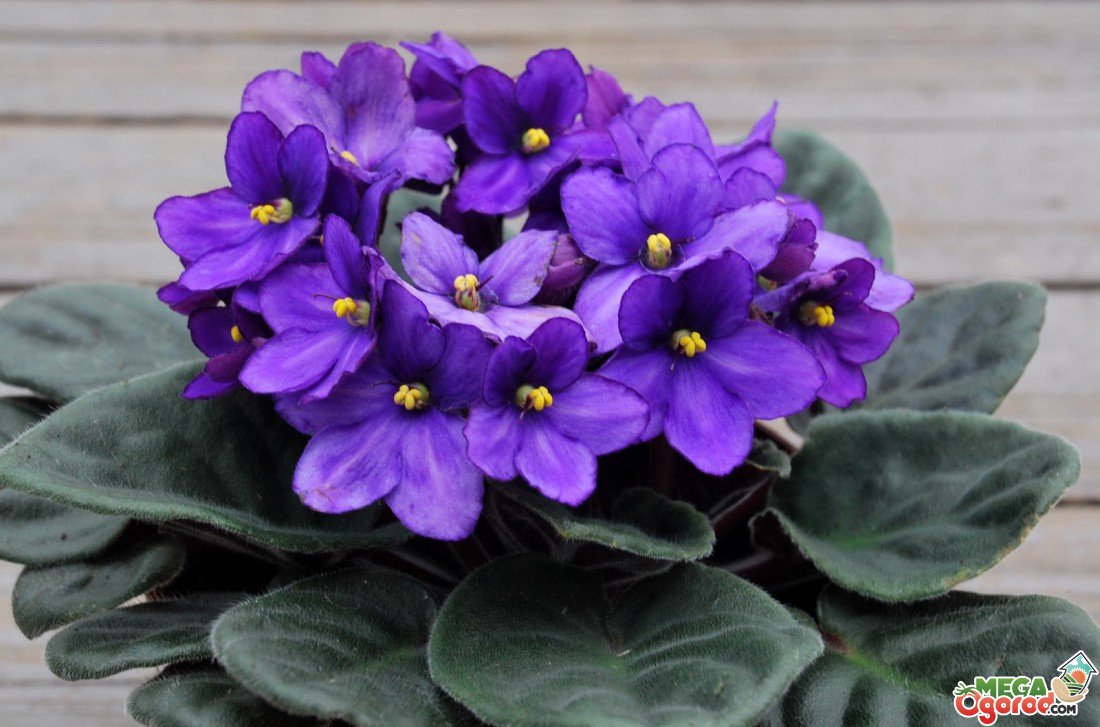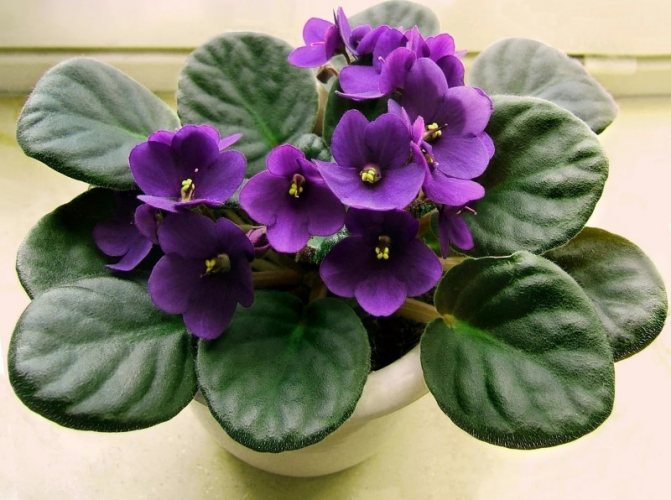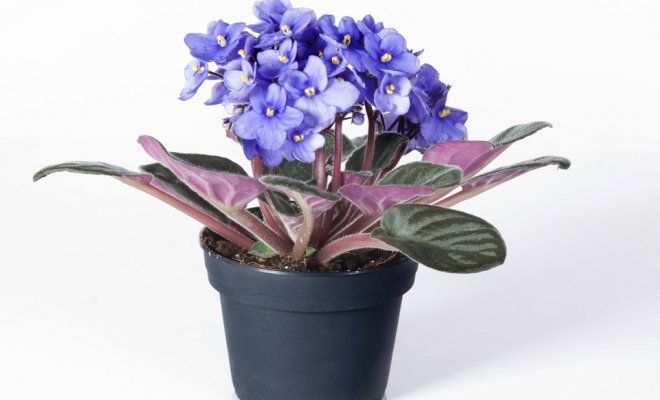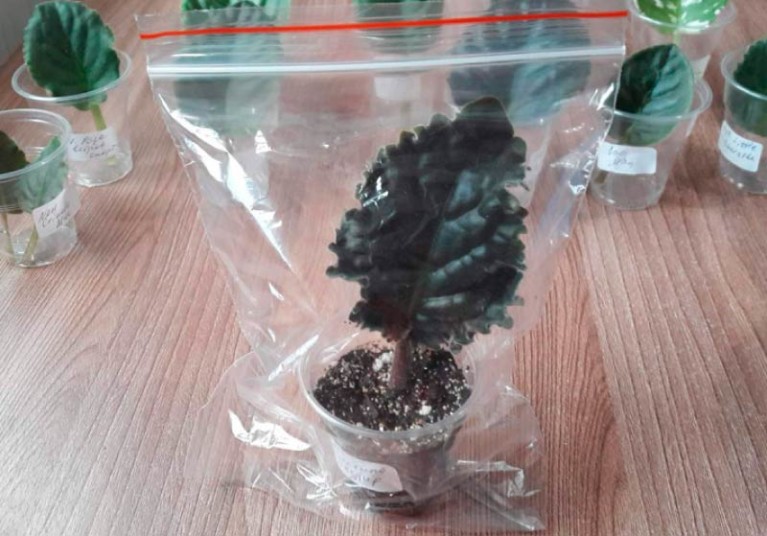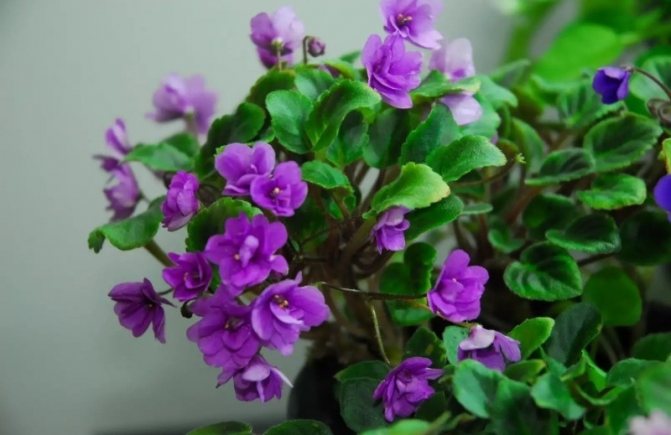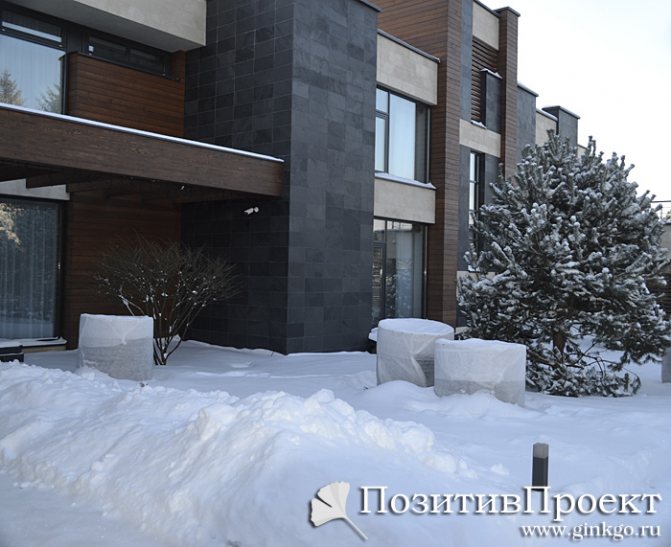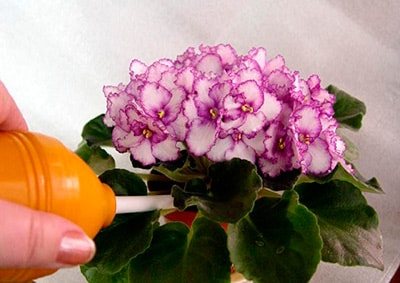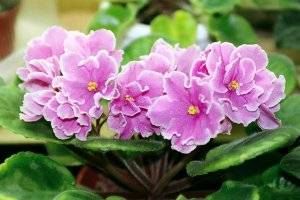How to transplant violets
Do you need a violet transplant after purchase? If the flower is industrial, then yes, it is better to transplant it into good soil right away, since in stores plants are often poured and oversaturated with fertilizers, and the quality of the substrate leaves much to be desired. If the violet is varietal, then you do not need to transplant it after purchase. If you bought a Saintpaulia baby in a glass, then the transplant should be postponed until the root system of the cuttings grows and fills the entire earthen lump in the glass.
- In other cases, a transplant is needed only in case of plant growth (once every six months or a little less often), soil overflow, the occurrence of diseases or pests, if the soil has become impoverished and oxidized (the stem is bare, the plant begins to wither).
- When can you transplant violets at home? The safest way to do this is in the fall, spring, in the cool period of summer. The ideal months for transplanting are April and May. In winter and summer, replanting a plant is possible only as a last resort.
- Keep in mind that replanting violets during flowering and budding is only in case of emergency. In this case, the flowers and buds will have to be removed.
- If you are carrying out an emergency flower transplant, then this should be done by the transshipment method, that is, with the preservation of an earthen coma, in which the plant has already taken root.
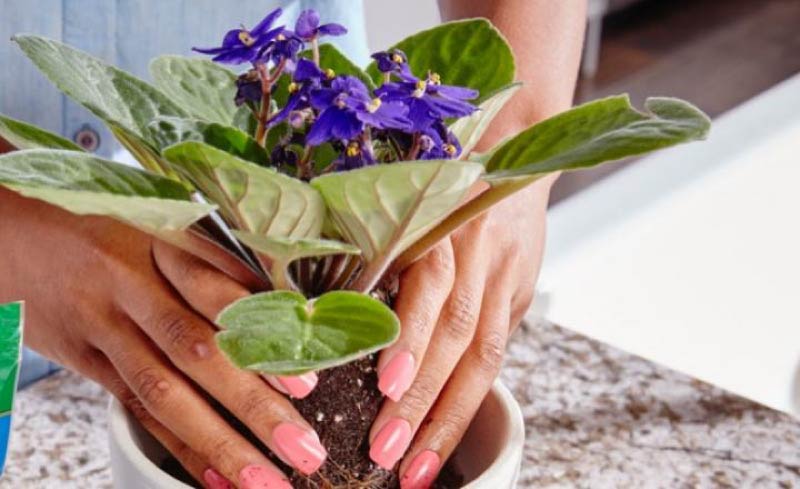
Here are step-by-step instructions for transplanting violets.
How to transplant violets at home
Step 1. Prepare the pot: wash it household. soap and disinfect if necessary. If you are replanting a grown plant, then pick up a pot slightly larger than the previous one.
Step 2. Put a layer of drainage (expanded clay, polystyrene) 1-1.5 cm thick on the bottom of the pot.
Step 3. Pour about 2/3 of the total mass of soil into the pot, plant the plant in it together with an earthen lump (shake it lightly here) to such a depth that the violet leaves do NOT come into contact with the soil. Sprinkle the remaining soil over the flower and tamp it down a little.
Attention! If you are replanting a plant due to the unusability of the old soil or suspicion of root decay, then the plant must be transplanted WITHOUT an earthen coma, completely and carefully clearing the roots from it. Further, before transplanting into a new soil, the roots of the violet must be carefully examined, cut off the rotten roots to a living place, and sprinkle the cuts with ground activated carbon. The upper part of the plant also needs to be rid of damaged, yellowed, dried out stems and leaves.
The upper part of the plant also needs to be rid of damaged, yellowed, dried-out stems and leaves.
Step 4. Do not water the flower for the first few days, but you can cover it with a plastic bag to maintain a constant moisture level.
Step 5. Two months after the transplant, you can start feeding the violet (see the chapter "Fertilizing violets").
Below is a visual instruction on how to transplant violets at home.
How to care for plants in winter: TOP top tips
1. Extending the lighting
The main task of caring for indoor plants in winter is to extend the daylight hours. This can be done using a fluorescent or ordinary electric lamp. Light it up when it gets dark outside. Daylight hours should be at least 10-12 hours.

The video has been deleted.
| Video (click to play). |
2. Thermal conditions
All plants that "live" on your balcony should be brought into the room in winter, otherwise they will not freeze.In general, the thermal regime depends on the characteristics of the plant. For example, aspidistra, aloe, cyperus, aucuba, lemon, zygocactus, ficus tolerate any temperature. But begonia, anthurium and violets are thermophilic, they need at least 15 degrees Celsius. Geranium, hydrangea, camellia and rose also love coolness. It is worth knowing that the temperature on the windowsill near the window is 3-4 degrees lower than the temperature in the room. Flowers do not tolerate drafts, so when you ventilate the room, cover them with newspapers, and the flowers between the frames with cardboard.

3. Correct watering
You need to water the flowers in moderation, excessive watering does not allow the earth to dry out, and it turns sour, the roots rot. Water the plants that have dropped their leaves less often, but do not allow the soil to dry out too much. The water should be at room temperature. Spray the plant periodically or wipe the leaves with a damp cloth. When dealing with pests, wash the leaves of the plant first with soapy water, then with clean water. Be careful not to let the soapy water get into the ground.

4. Make-up
In winter, plants need to be fed less often than in summer. Feed the plants that bloom from the appearance of buds and until they bloom. All the rest - 1-2 times every 2-3 weeks. In winter, it is better not to replant the flowers, but to do this in early spring.
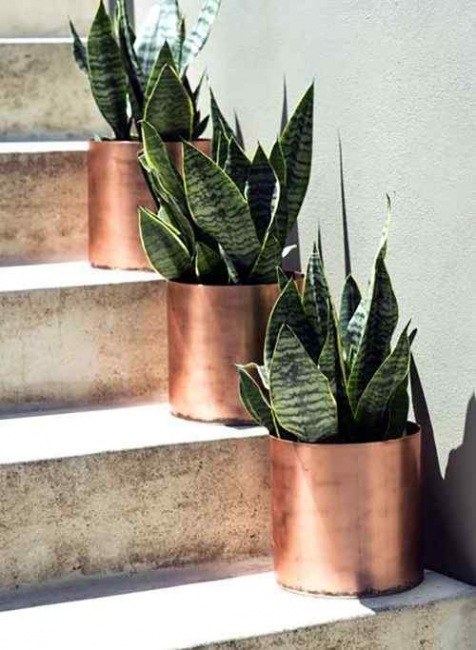
All of the above recommendations are general. Each indoor plant requires individual care.
With the arrival of winter, most indoor plants begin to ache and wither: all summer they felt great, and delighted us with their flowering and beauty, but now they need our help, and here they need an individual approach to each plant. However, there are common problems that almost all indoor plants suffer from - low humidity and a drop in air temperature.
Therefore, caring for indoor flowers in winter should be special and caring, and then they will feel good all winter and will bloom too, despite the short daylight hours and winter cold.
The enemy of violets is dry and hot air
Hot and dry air emanating from radiators is very dangerous for violets. It can cause pests to appear on the leaves, yellowing and drying of the leaves.
Attention! Dryness and heat in winter is not desirable for violets. In such conditions, the buds do not form well, which can lead to poor flowering during the growing season .. In autumn, as soon as the batteries are turned on, cover them with damp towels or other cloth
Moisten towels regularly. You can place containers with water around the flowers
In the fall, as soon as the batteries are turned on, cover them with damp towels or other cloth. Moisten towels regularly. You can place containers with water around the flowers.
It turns out that the cold affects the flowers from the window, and heat and dryness from the batteries under the windowsill. It is necessary to protect violets from both.
Conditions of detention
When you buy a violet from the store, leave it isolated from other plants in the house for 2 months to avoid the transmission of possible diseases or parasites. If not a separate room, then at least a place remote from the flower garden will do. If you bought a violet from a private grower you trust, then you can choose a permanent place for it right away. The table shows the recommended and non-recommended requirements for keeping violets at home.
| Violets love ... | Violets DO NOT like ... |
|---|---|
| Lots of sunshine | Direct sunlight, especially at noon - leaves can get burned |
| Daylight hours are about 13 hours and supplementary lighting with phytolamps in winter (only under this condition will the violets bloom in the cold period) | Drafts and sudden temperature changes. For this reason, it is better not to put violets on an open balcony in the summer. |
| Room temperature around 24 degrees or slightly lower in winter | Cool air below 15 degrees. In such a climate, violets stop growing and blooming. |
| High air humidity | Water drops on leaves and flowers. Therefore, Saintpaulias do not need to be sprayed. |
The bloom of home violets decorates the windowsills very much. And due to the fact that Saintpaulias are usually small in size, this plays into the hands of the owners of small apartments.
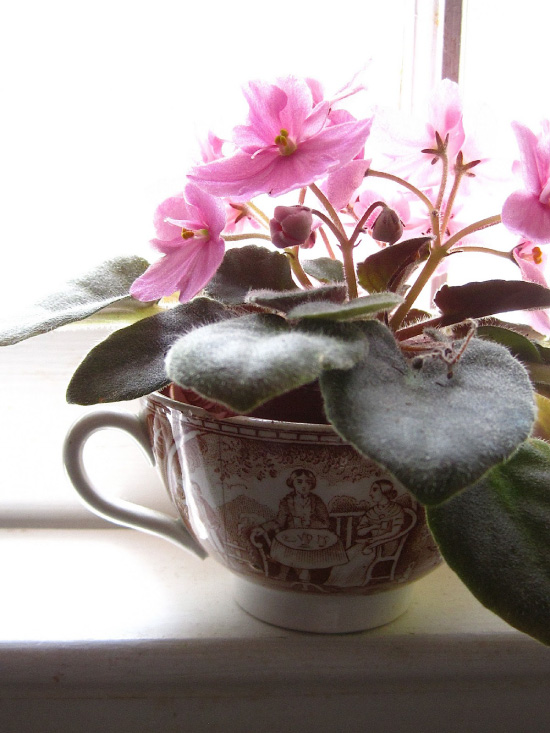
In the summer, it is undesirable to take violets out to an open balcony, since they do not very well tolerate temperature changes at night. But on the loggia (see photo below), where the temperature does not drop below 15 degrees, violets will feel good.
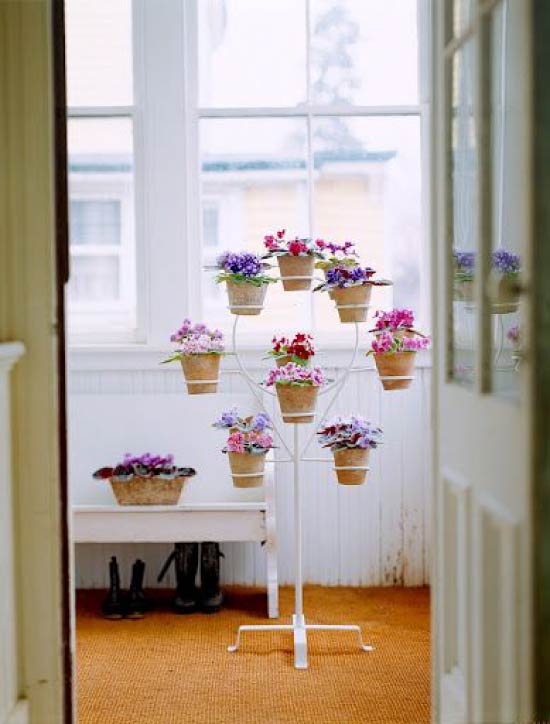
If you want the violets to bloom in winter, arrange additional lighting for them with LED or phyto-lamps.
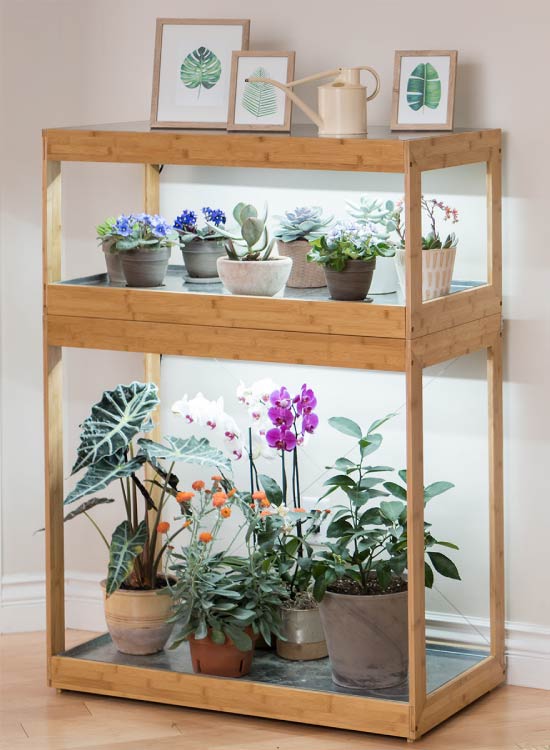
Features of caring for a room violet at home
Do not confuse the indoor violet (Saintpaulia) with a wild-growing species, because the specimens that everyone is used to seeing on the windowsills belong to the Gesneriev family, and real mountain specimens look a little different, one of the brightest representatives is garden Pansies. Saintpaulia flowers consist of 5 leaves, the color can be different depending on the variety. The leaves are dense, fleshy, with a characteristic "fluff", collected in a rosette, which somewhat complicates the care of indoor violets.
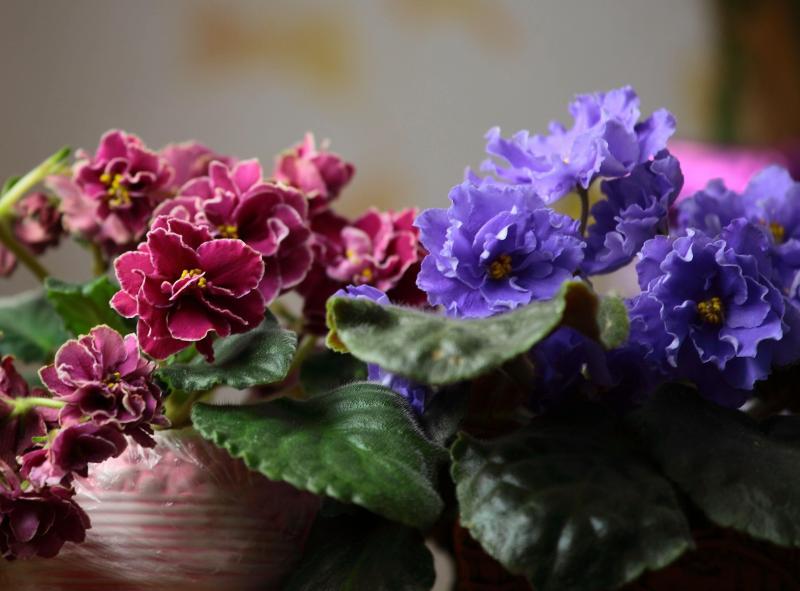
Violets need a lot of light, it should be bright, but at the same time diffused through a light tulle. For this reason, it is not recommended to keep them in rooms on the north side, it is better to choose windows facing east or west so that the plants receive the soft light of morning or evening rays. For abundant flowering, the duration of daylight hours should be 14 hours, therefore, starting from autumn, it is advisable to use additional illumination with phytolamps.
Air temperature
A stable indoor temperature is a guarantee of a healthy plant, because Saintpaulia does not tolerate sudden changes and drafts. The air should be moderately warm, from +18 ° C to +24 ° C. Strong heat is contraindicated for indoor violets and threatens their death, so in the summer months you need to carefully monitor the weather conditions and try to provide the flower with a cooler place. Such careful home care for the violet will definitely be rewarded.
Air humidity
Indoor violet prefers rather humid air, but it must be remembered that in no case should you spray the plant. Moisture evaporates more slowly from leaves covered with "fluff", and this can lead to the appearance of fungal infections. It is better to place a beautiful decorative plate with river pebbles on the windowsill with flowers and replenish it with water in a timely manner. Once a month, you can gently wash off the dust from the leaves with warm water from the shower, but after that be sure to blot the remaining drops with a napkin. Considering that the rosette of leaves is located close to the ground, it is recommended to wrap the pot with polyethylene before the shower, this will prevent excessive moisture in the soil.
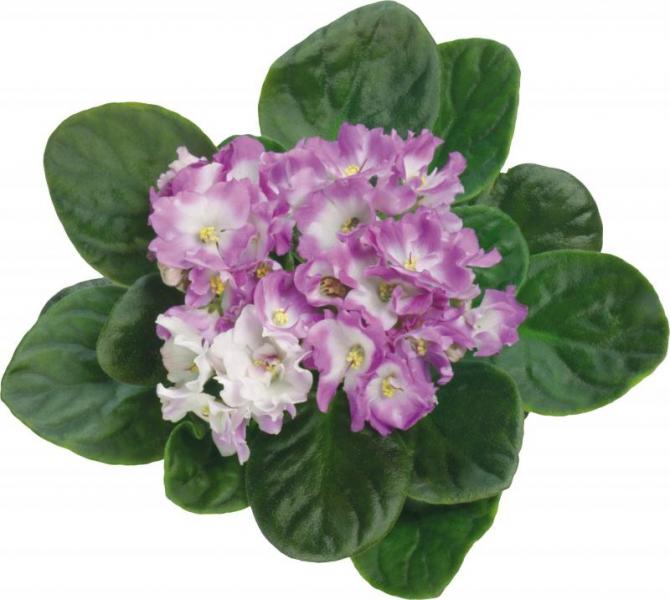
Watering room violets
As already mentioned, due to the leaves collected in the root rosette and due to their close location to the top layer of the soil, the watering procedure can be extremely difficult and tedious. After all, water in no case should fall on the leaves or into the outlet. For this reason, florists recommend using bottom watering by submerging the pot with drainage holes in a container of water for 10 minutes. Water for irrigation should be cleaned of chlorine in a timely manner and heated to room temperature. Water that is too hard will cause limescale to build up on the rim of the container, so it is recommended to soften it. Watering the violet is enough 1-2 times a week, but regularly checking the soil, because a lack of moisture is no less dangerous than an excess.
Advice! In order not to fear excessive waterlogging of the substrate or, conversely, the drying out of the earthy coma, it is recommended to provide the violet with a wick irrigation system.
Soil composition and choice of pot for growing violets
For good care of indoor violets, light and loose soil is needed; you can easily purchase special soil for Saintpaulias in stores. If such a mixture was not found, then you can prepare it yourself:
- leaf land - 2 parts,
- sod land - 1 part,
- fresh humus -1 part,
- sand - 1 part.
You can add some charcoal to the pot and be sure to provide drainage, which should occupy at least 25% of the total volume of the container.
Containers for growing Saintpaulias should be selected small, because the root system does not grow too much. Experienced flower growers recommend that when choosing a pot, focus on the diameter of the outlet - the container should be 3 times smaller. So, for young specimens, glasses with a girth of only 5-6 cm are enough.

Fertilization
Indoor violet - home care involves regular feeding. During the period of active leaf growth, it is necessary to purchase formulations with a higher nitrogen content, and with the appearance of the first buds, switch to potassium-phosphorus fertilizers. Most manufacturers have developed liquid fertilizers specifically for Saintpaulias, such as in the Bona Forte or Garden of Miracles line. It is enough to apply top dressing once every 10-14 days; in winter, the violet does not need additional nutrition.
How to propagate a violet?
Saintpaulia can reproduce in a generative and vegetative way. Since it is impossible to preserve varietal characteristics with the seed method, the most simple and productive technique is cuttings.
Leaf propagation is carried out throughout the year, while:
- A well-developed leaf blade is separated together with a petiole and placed in a container with water.
- After root formation, the cutting is planted in a pot with potting soil.
- The sheet is placed immediately in a special substrate, after which the dishes with the handle are covered with glass and a warm room with good lighting is moved, where there is no direct sunlight.
- The substrate is systematically moistened with a spray bottle.
Rooting can take a long time, so do not rush to get rid of the cutting for this reason.
Differences in winter care for violets
Considering the features of caring for violets in winter, it should be clarified that warmth and good lighting are far from the only nuances that must be taken into account when growing.

In the cold season, flowers need special care.
In winter, as in summer, home-grown violets should be given special attention. This applies not only to the temperature regime and lighting, but also to the requirements for the soil for cultivation, as well as the winter watering and feeding regime.
Since these nuances have their own characteristics, we will consider each of them in more detail.
Lighting requirements
The homeland of Saintpaulia is Africa, but this does not mean that violets love bright light. Despite their thermophilicity, they prefer to grow in the shade, although in general they need more light than other houseplants.
A cloudy but warm enough day is considered ideal for Saintpaulias. In this case, the duration of daylight hours should be at least 10 hours. Considering that such conditions in our climate are very rare, you will have to take care of artificial lighting as the main stage in caring for a violet.
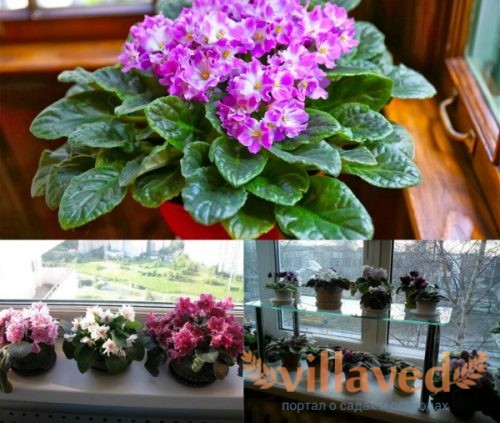
Lighting for indoor flowers
One of the features of these plants is the fact that they can bloom even in winter, but only if the length of daylight hours is optimal. If the amount of light is not enough, the violet will sleep more than actively grow and release buds. Given this feature, it is advisable to install lamps for additional illumination. For this, you can use ordinary fluorescent lamps, but experienced florists recommend using special phytolamps.They are installed above the plant pots and turned on in the morning and evening. In winter, the total daylight hours should be at least 10 hours.
Watering rules
In winter, all plants need less moisture and Saintpaulia is no exception. With the onset of cold weather, violets can be watered in the same way as other plants, although in summer the culture is replenished with moisture more intensively.
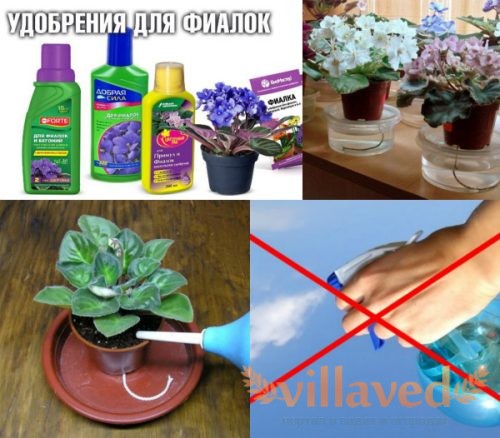
In winter, the number of watering and dressing is reduced
In order to prevent root decay, watering violets in winter is carried out only after the soil in the pot is completely dry
At the same time, it is important not to allow an excess of moisture, therefore, watering is carried out no more than once a week.
Plant feeding
Similar to watering, caring for violets in winter from the point of view of fertilizing also has its own characteristics. If in the summer, to activate flowering, plants are fertilized quite often, then in winter, feeding is almost completely stopped. To saturate the plant with useful substances, fertilization is done no more than once a month.
Do not be afraid that such a rare feed will damage the flower. If the size of the rosette remains normal, and the leaves are green, it does not make sense to overfeed the plant, since in the cold season the flow of juice along the stems and leaves slows down. It is better to postpone the procedure until spring, when the plant, weakened after wintering, will be in dire need of nutrients.
Temperature conditions
Under natural conditions, a comfortable temperature for Saintpaulias is considered to be + 20 + 25 degrees, therefore, at home, you need to try to recreate a similar temperature regime.
If it is too cold in the room where the violets are located, the inflorescences may begin to crumble at the flower and burns of the leaves appear. If this has already happened, the plant needs to be moved to a warmer room.
It should also be borne in mind that in winter, when the heating is on, the air humidity decreases and does not become unsuitable for violets. Given this feature, it is recommended to place pots with plants at some distance from heating appliances, and next to the containers, place cans of water or a stationary humidifier that will help maintain an optimal level of humidity.
Transplanting violets during flowering
It is necessary for all growers to know how to properly transplant a violet when it blooms. There is hardly a florist who wants to interrupt the picturesque flowering process without a good reason. But, if the reason really exists, then it is better not to hesitate, otherwise the tender and moderately capricious Saintpaulia will begin:
- Waste away;
- And it will lose its presentable appearance quickly enough.
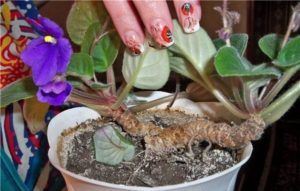 In what cases is it worth risking replanting a blooming pet? All reasons are associated with problems around the root or root system.
In what cases is it worth risking replanting a blooming pet? All reasons are associated with problems around the root or root system.
Some of them may wait for the planned transplant or the end of flowering, but there are those that require immediate action:
- Swampy soil mixture;
- Soil salinity;
- Acidification of the earthen coma;
- Putrefactive processes in the root system, accompanied by a musty smell of the soil;
- Destruction of a flower pot;
- Significant overfeeding with fertilizers;
- Abundant colonization of parasites.
Even one reason does not allow the plant to fully develop and receive a sufficient amount of nutrients during such an important period. Waiting for the deadline for a planned transplant can simply lead to diseases or even death of the plant.
The violet must be transplanted into another pot.
If at room violet:
- Strongly overgrown flower rosette;
- Increased growth of the root system;
-
A small number of parasites, the bulk of which are removed by immersion or drugs.
Important! In these cases, if the plant develops, blooms beautifully, you should wait for the planned transplantation date and not test it for stress resistance.
It is best to replant the violet during flowering in spring.
Main reasons
The condition of the soil is very important for the development and growth of violets.
Particular attention should be paid to the acidity of the soil. pH in the range of 5.6-5.9 is ideal for full development of violets
Acidity values outside this range make nutrients unavailable for Saintpaulia.
Acidification caused by poor-quality water during irrigation or excessive use of fertilizers causes:
- Yellowing sheets;
- And falling buds.
The lack of phosphorus-nitrogen nutrition affects the development of the plant and requires urgent replacement of the soil.
The appearance in the ground or underground part of microscopic parasitic insects, sometimes invisible to the armed eye, can significantly disrupt the viability of indoor pets. Feeding on the juices of plant parts and especially disturbing the structure of young roots, they destroy the delicate plant before our eyes.
Important! Infectious diseases: fungal, bacterial or viral, have the ability to multiply rapidly and destroy the delicate violet in a matter of days.
Only a change of soil mixture, coupled with a treatment procedure, can save indoor Saintpaulias.
Do you need to remove buds and peduncles?
An emergency transplant associated with disease, soil depletion or pests is carried out regardless of:
- Vegetation stage;
- And the time of the year.
During the flowering period, a forced transplant has its own characteristics. In this important phase for the plant, it spends all its strength and energy on education:
- Butonov;
- Tsvetkov;
-
Fruit with seeds
The main purpose of the violet is to produce offspring. But for this she needs to increase the corresponding volume of the crown and root mass. After transplanting in the flowering phase, the violet first of all needs strength to adapt and grow roots in the new soil.
And if you do not remove the existing or formed buds and flowers, then she simply will not have enough strength to devote them to flowering and building other parts of the plant. It will weaken and will recover for a very long time.
Therefore, having decided to transplant a blooming violet, the florist needs to free it from buds and flowers so that she can direct all her strength to overcome stress and root survival.
The process is simple, but exciting. We just take and cut off all the buds and flowers before removing the Saintpaulia from the pot, with the hope that the strengthened, transplanted plant will soon shoot a lush nodding flowering. After transplanting, the flower needs careful care.
Can you help us meet spring?
In March or early April, the home-grown plant begins to wake up, so during this period of time it can already be moved to a cool windowsill, where it will get used to bright lighting, while avoiding northern windowsills.
After a few days, you can start increasing the amount of water while watering. It must be at room temperature, settled. At this time, while the begonia gets used to the new conditions, its tuber will begin to germinate, and it will gradually begin to bloom. This is all you need to do to help the flower wake up if it has wintered in a pot. How to properly grow, water and care for begonia so that it blooms longer, we told here.
If in winter the plant tuber was stored in soil or sand, it must be planted for germination: planting in a container with a wet substrate according to the 5x5 scheme, or immediately in individual pots (how to choose a pot and plant a begonia, read here). Boxes or pots where tubers germinate should be watered moderately, and also placed in a room with a temperature of 16-17 degrees.
It is possible to transplant sprouting tubers into open ground only when the stem grows and leaves appear on it, i.e. after about 2 - 3 weeks.
It is best to time the tubers to sprout by the time the spring frost is due to end.
During the dormant period, begonia does not require absolutely any attention to itself, therefore it is very simple to make it so that next year it will delight you with its bright and graceful flowers
And it doesn't matter who is doing it: a beginner in this business or an experienced gardener
When the dormant period begins in begonias. Dormant period and awakening of tubers
The period of rest or hibernation in ever-flowering begonia begins in November and lasts until the beginning of spring. With the help of this event, the plant hides from the cold. The main task of flower growers during this period is to preserve the tubers and protect them from drying out.
If the flower is sent for storage early, she may not have time to prepare for bed, since the supply of nutrients at this moment will be insufficient. Therefore, you should not rush and remove the flower at the very beginning of autumn. The optimal time is late October - early November. The main thing is to be in time before the onset of freezing.
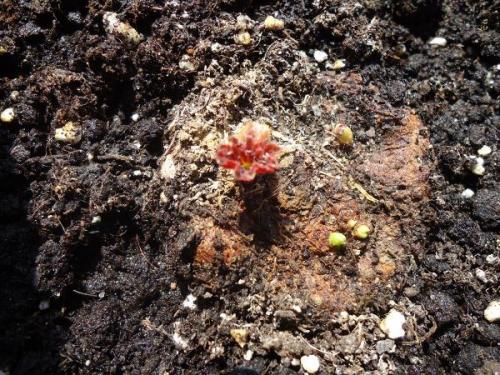
Tuberous begonia awakening after wintering
With the onset of warmth, namely in March - April, the buds of the flower swell and the flower comes out of the state of sleep. At this time, it is necessary to carry out cuttings and plant in a peat mixture.
A couple of months before planting, the tubers must be removed from the container in which they were stored and planted in a container for germination.
The tubers should be planted so that their crown looks up. It is usually concave or flat, with kidneys. For germination, you need warmth, at least 18 degrees, and daily watering. The first shoots will appear in a few weeks.
Tubers can be divided, the main thing is that on each part of them there are several buds. The place of the cut is processed with ash or charcoal. It is advisable to treat the places of cuts with charcoal.
It is recommended to plant sprouted flowers in open ground in early summer. The place for this should be sheltered from the wind, with fertilized soil. Direct sunlight should also not hit the flower.
Difference between wintering begonia at home and outdoors
Caring for tubers of home and garden plants is significantly different. To properly prepare them for winter, you should take into account some of the features of both:
Outdoor begonias are much larger than indoor potted tubers. Garden flowers should be removed at the onset of the first hard frosts.
The rule of the golden mean is important here, since the first light frosts are not able to kill the plant, so there is no need to rush either. Let the flower gain strength and prepare for hibernation on its own
The optimal time is when the leaves and stems of the plant will die off by themselves. After that, the stems are trimmed, and the tubers themselves are placed in a box and left so that they can dry out. After that, containers with plants are removed for storage until spring.
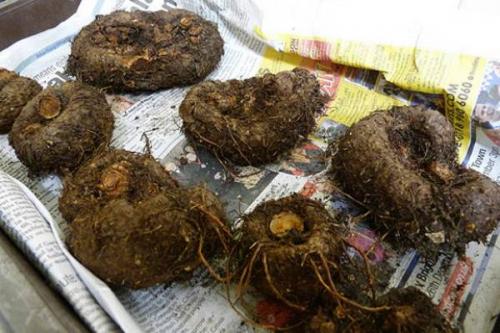
Begonia tubers are dug up for the winter and placed in a box
- Caring for a home plant in winter looks a little different. The tubers are not dug out, but remain in their pots. At the first appearance of wilting of the stems, they are also cut off. Watering from this point on is reduced to a minimum. In the spring, Begonia is necessarily transplanted into new soil, having previously divided it into several parts, if many buds have formed on them.
When buying an already sprouted home Begonia at the end of summer, be sure to check if the flower in the pot has tubers. Since there are varieties of annuals. They do not leave tubers and their lifespan is only one season.
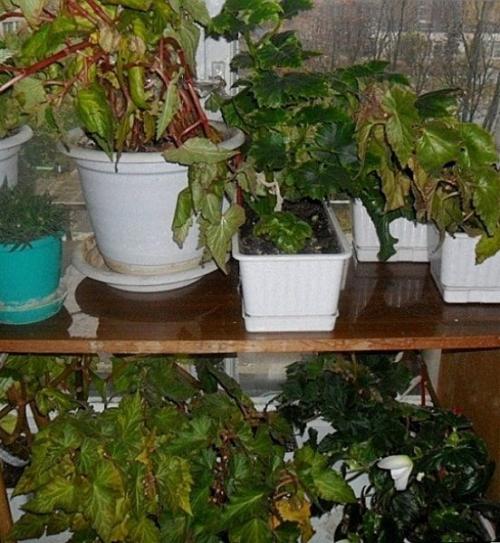
Green leaves of begonia cannot be plucked, thereby forcibly laying the flower to rest
It is not uncommon when homemade Begonia does not shed its leaves for the winter and remains green. In this case, you do not need to trim it. The plant remains in place until the spring transplant.
Is it necessary to dig for the winter?
Begonias are thermophilic flowers, so preparing them for winter is very important for further growth. When answering the question "is it necessary to dig it up for the winter", it is worth considering the type of plant and the state:
- Street growers advise large tubers to dig out after wilting and place them in a bowl with peat in a cool place.
- Large tubers of domestic plants are left in pots in the same place for the whole winter.
- Sprouted seed begonias and flowers with small tubers are also harvested and stored in a cool, light place.
Technology
To transplant a violet - take small preparatory measures. And above all, prepare the plant itself for transplanting. Just evaluate the condition of your Saintpaulia:
- The overgrown lower leaves can be removed;
- Refresh the roots. Remove dry and diseased;
- Treat pests. If the transplant is associated with their appearance;
- Preventive treatment for diseases will not be superfluous;
- Prepare the required container and substrate.
Removal of peduncles
But most of all you will be concerned about the question - what to do with flowers and peduncles:
- It is a pity, but they will have to be removed. No matter how beautiful and strong they are;
- And you must do this 2-3 days before the transplant. So that the slices dry a little.
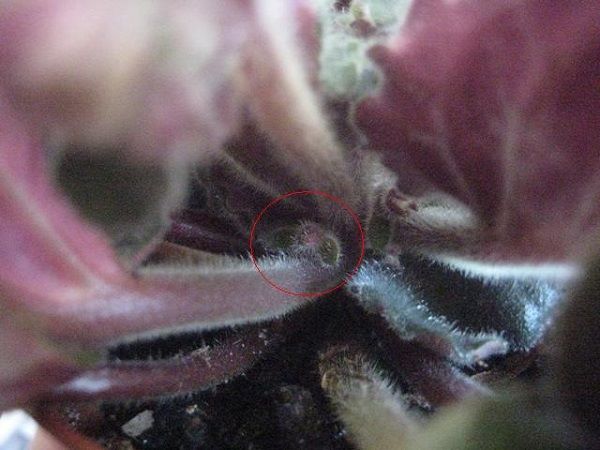
All peduncles must be removed before transplanting.
Replacement of soil
For the uzambara violet, simple earth will not work. Many specialty stores offer ready-made soil mixes for violets. They contain all the necessary components for such plants:
- Chernozem, sod land, soil from under coniferous trees;
- Peat;
- River sand;
- Sphagnum moss;
- Perlite;
- Vermiculite;
- Charcoal.
There are various options for their composition.
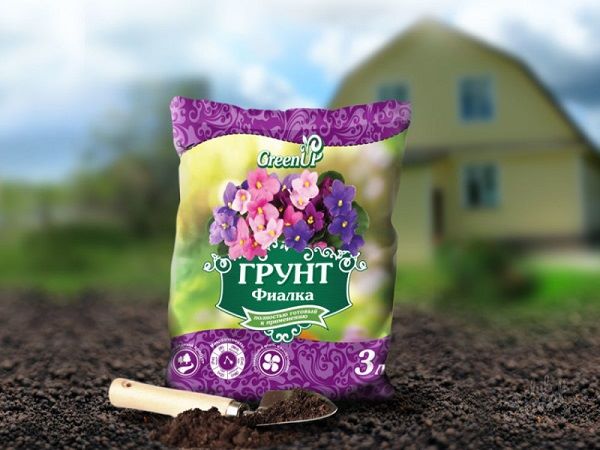
Experienced growers themselves prefer to prepare such a substrate. Steamed and treated with potassium permanganate.
Important! In any composition, the substrate must pass water and air well. Light and crumbly .. It is not so difficult to assess the condition of the soil:
It is not so difficult to assess the condition of the soil:
- It is recommended to completely change to a new one if the lump of earth in the pot does not much resemble the substrate. Strongly compacted and poorly permeable to moisture:
- Whitish bloom indicates increased acidity;
- A bare stem indicates the need for such a procedure;
- Like a wilting plant;
- If the roots of the violet are overgrown. And they even look out of the pot through the drainage holes.
- You can limit yourself to a partial replacement of soil;
-
The transshipment method is very often used when transplanting flowering Saintpaulias. From one container to another:
- If the containers are damaged and the substrate is in good condition, it is simply irreplaceable. You just need to add missing fresh soil on the sides;
- For plants, this option is more favorable.

Favorable time of the year
The spring period is most suitable for transplanting them:
- The April (May) warmth after winter allows you to quickly overcome post-transplant stress. Florists and experts are unanimous in this;
- The extreme temperatures of winter and summer are not entirely favorable for such procedures;
- Experienced lovers of these flowers create ideal conditions for their favorites. Additional lighting and a stable temperature make it possible to transplant Saintpaulias in autumn.
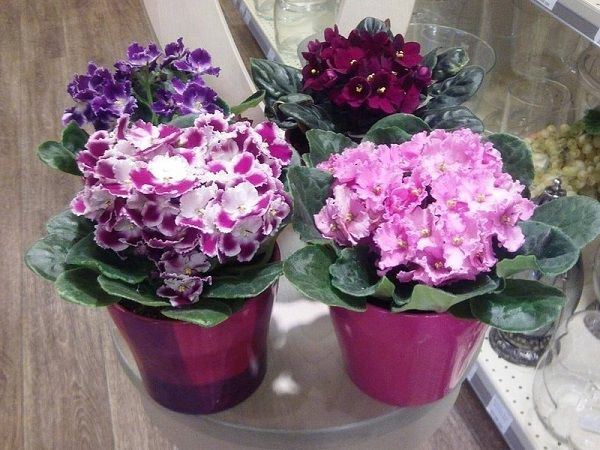
They advise to pay attention to the lunar calendar:
- When the moon is waning, the roots develop well. So it is better to transplant during this period. Watering is advised less;
- With the growing moon, adults are seated in new pots and the young are planted. But you need to water more;
- Do not make any transfers on the days of the full and new moons!
Fundamental rules
The success of the transplant depends on you
Pay attention to the importance of each stage of the transplant:
- Prepare violets for transplanting. We have already talked about this a little earlier;
- Choose the right container:
- Not only aesthetic and beautiful appearance is important. But also their size. Only 2-3 cm larger than the root system;
- Treat the inner surface with a solution of potassium permanganate.
- Prepare good soil. Purchased special or prepared by yourself. But high quality;
- Place a layer of drainage on the bottom of the pot. Made of expanded clay, small foam, small pebbles.At your discretion. And according to your capabilities.
The transplant procedure itself. Transplant with slightly damp soil:
- Remove the plant from the old pot. Examine. Peel dry roots. Remove the bottom leaves. If they are yellowed. With cuttings;
- Lightly crush a clod of earth;
- Lightly pour prepared moistened soil on the drainage layer;
- Set the violet on the ground in the center. The lower leaves are at the level of the edges of the pot. Or half a centimeter lower;
- Cover with soil. Tapping around the edges of the pot;
- Water in small portions every 3-4 days.
How to care for flowers in winter at home
It is with saving flowers from the cold that it is worth starting winter care: in many of our apartments in winter it is not as warm and comfortable as we would like. There are enough reasons for this, and one of them is drafts: not everyone has high-quality plastic windows yet, and ordinary wooden frames almost always let the cold through. Old windows with cracks should be sealed, since you cannot change them yet, and the flowers should be moved so that their leaves do not touch the cold window panes - it is because of this that leaves and flowers often shrink and crumble in winter. If possible, for the winter it is better to place flowers in the light, but not on windowsills - especially thermophilic species.
If the flowers remain on the windowsills, and it is still cool in the apartment, you need to insulate the flower pots - at least put them on foam plastic. Better, of course, to put all the pots in a spacious wooden box filled with foam crumbs, or put a soft warm cloth between the pots.
In cases where this condition is also impracticable - for example, due to the tightness in the apartment, you need to immediately choose not clay pots for planting flowers, but plastic ones - so they will be a little warmer.
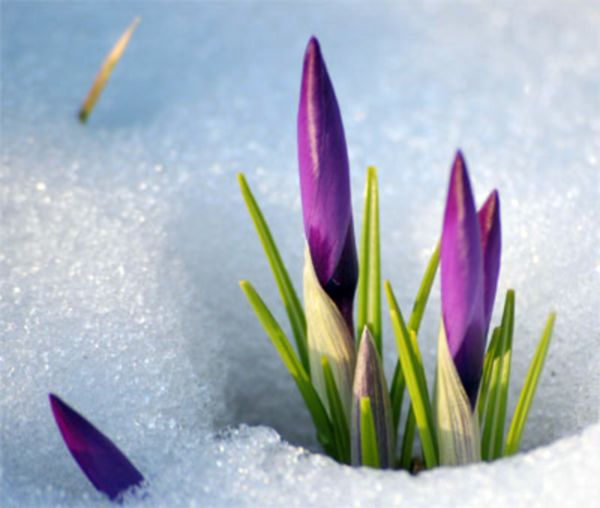
Heat-loving indoor plants in winter should not be kept on the windowsill - they need to be removed where it is warmer, but they should have enough light. It is necessary to rotate flower pots regularly: in winter it is especially difficult for them to "catch" sunlight, because the sun does not rise as high as in summer. As soon as you notice that the leaves of indoor plants have begun to turn yellow and fall off, immediately rearrange them to a warmer place. However, flowers should not be rearranged often: they "get used" to a certain place, and constant movement can worsen their condition.
Soil depletion
Over time, the soil due to prolonged vegetation:
- Depletes;
-
Salted.
Waste plant activity, accumulated after watering, fertilizing with fertilizers, the work of the root system and just time, make the soil:
- Dense;
- Caked;
- With accumulated salts;
- And sometimes white bloom on the surface.
In this state of the soil mixture, the violet cannot develop and begins to wither. The shape and color of the leaf plates is lost, the flowers become smaller and fall off.
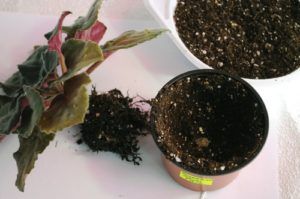 The flowering time is shortened and over time the plant may simply die. The root system in such a state of the soil cannot fully work, which ultimately leads to the death of the plant.
The flowering time is shortened and over time the plant may simply die. The root system in such a state of the soil cannot fully work, which ultimately leads to the death of the plant.
Soil depletion, compaction and salinity directly depend on:
- From the quality of the soil mixture components;
- On the quality of irrigation water;
- And the amount of fertilizer applied.
Advice! According to experienced florists, a complete soil replacement should be carried out annually, or even once every six months.

